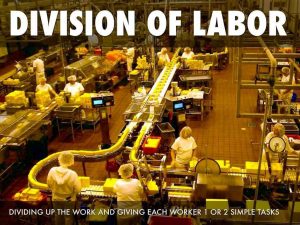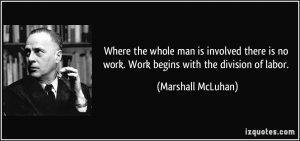Adam Smith (1723 – 1790) identified the division of labour and specialization as the two key means to achieve a larger return on production. Division of labour is an economic concept which states that dividing the production process into different stages enables workers to focus on specific tasks. If workers concentrate on one small aspect of production, this increases overall efficiency. When employees concentrate on a specific task, with time they improve the necessary skill which is useful for a specific task and they perform better and faster which saves time and money, and enables increased production levels.
Smith found that factories in which employees specialized in only one or a few tasks had greater performance. In his famous example of a Pin Factory which he visited, each employee performed all 18 pin-making tasks. In fact, Smith found that 10 employees specializing in a particular task could, make 48 000 pins a day, whereas those employees who performed all the tasks could make only a few thousand at most. Smith reasoned that this difference in performance occurred because the employees who specialized became much more skilled at their specific tasks, and, as a group, were thus able to produce a product faster than the group of employees in which everyone had to perform many tasks. Smith concluded that increasing the level of job specialization, the process by which a division of labour occurs as different employees specialize in different tasks over time, increases efficiency and leads to higher organizational performance.
Fredrick Taylor (1856 – 1923) aimed at continuously increasing the efficiency of the production process. He divided labour into an elementary division of labour in which every worker was allocated their own tasks that had to be repeated constantly. Everyone was assigned their own program that consisted of successive actions and this was aimed at worker’s levels of knowledge and skills. This brought about considerable time savings and because of this routine, productivity increased rapidly. Taylor felt it was important to select the right person for the right job and to leave the planning and thinking to the specialists.
Division of labor allows economies of scale (ES). Economies of scale are the reduction in per unit cost of production as the volume of production increases. In other words, the cost per unit of production decreases as volume of product increases. Costs per unit can decrease as the volume of production increases for different reasons. ES helps at increasing cost advantages that a business obtains due to more units of output.
Division of labour allows specialization. Firms producing at a large scale employ a large number of workers. This allows the firms to practice specialization by splitting jobs into smaller tasks. These individual tasks are assigned to separate workers. In this way workers spend all their work time on the part they know best and it also allows them to perfect their skills. Overall result of this is that an average unit is produced at lower cost. Specialization also works at management level. For example in an organization you will find Marketing team, Human Resource Management team, Finance team, Operation team, Risk Management Team, Procuring team, Information Technology team etc, etc. On a small scale, a Civil Contractor while construction a house divides the work into civil engineer, supervisor, masons, and site labour, welder, plumber, electrician and interior designer.
Henry Fayol (1841 – 1925) recognized that division of labour leads to specialization and that specialization is considered as part of “the natural order” comparing it to the organs of the body. For example the GI tract (Gastro Intestinal which is responsible for digestion in body) are the mouth, esophagus, stomach, small intestine, large intestine, the rectum and anus. Food enters the mouth and passes to the anus through the hollow organs of the GI tract. The liver, pancreas, and gallbladder are the solid organs of the digestive system. Each of the organs listed herein is responsible for diction of food once it enters our body.
The object of division of work is to produce more and better work with the same effort, Fayol described. Fayol also said that division of labor helps in learning. As business firms grow, they learn from both experience and research. Firms gradually learn-by-doing and become more and more efficient. Firms also learn from research which results in better processes and new formulas pushing their production cost per unit even lower.
This very objective has not been altered in today’s modern business world. In a sense this principle is the fundamental feature of modern economy, allowing for the largest increases of productivity. Peter F. Drucker (1909 – 2005) said that the 20th century has seen a rate of 3% productivity increase per year, hence productivity rose 50 fold since the time of Frederick Taylor, who acted as a catalyst in the development of division of work.
An example of this fact can come from early industrialization, namely the Ford motor company, where Taylor’s system of a scientific approach was applied. Fredrick Taylor was interested in skill development by means of standardization and functional specialization. One worker would assemble the dashboard, another would assemble the wheels, and yet another would paint the exterior. The effects of the division of labour are well known and lead to Ford becoming not just the predominant car maker but also the inventor of the conveyer-belt production system- revolutionizing many industries.
However, one could argue that extremes of division of work could lead to undesired effects. Division of labour can ultimately reduce productivity and increase costs to produce units. Several reasons as causes for reduction in productivity can be thought of. For example, productivity can suffer when workers become bored with the constant repetition of a task. Additionally, productivity can be affected when workers lose pride in their work because they are not producing an entire product they can identify as their own work.
On the flipside, Douglas M. McGregor (1906 – 1964) cautioned that people would get bored doing the same job again and again. Repetition of same work bores people and kills enthusiasm. Fayol probably had recognized this fact earlier in his work. He stated that the division of work has its limits which experience and a sense of proportion teach us may not be exceeded. In more recent years management thinkers have recognized and addressed this issue more intensely.
Karl Marx (1818 -1883) warned that repetition of work leads to process of disaffection. In his view, workers would become more and more specialized, and work would become more and more repetitive, until eventually the workers would be completely estranged from the process of production. While it can have benefits on productivity, the specialization of labour can lead to workers with low overall skills and low enthusiasm.
Leo Tolstoy said that division of labor is a justification for sloth (laziness).
















































